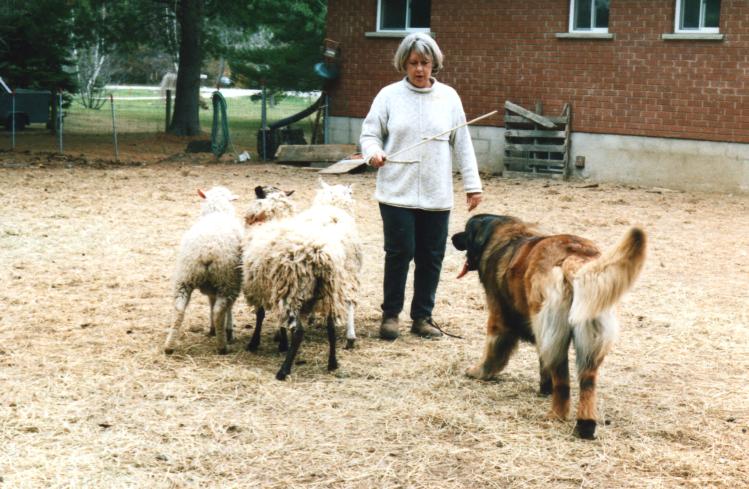|
Leonbergers At Work – Herding Training Leonbergers are not well known for their herding ability but if you look at their ancestry, quite a few breeds in their background were used as flock guardians. To begin, all you really need is yourself, your dog and something to herd. Because Leos are a substantial dog it is best to use sheep, although bear in mind that not just any sheep will suffice in the training process – they must be accustomed to being worked by dogs.
Orovale's Cool Hand Luke, HIC, TD ("Luka") Herding ability is an inherited trait just like temperament, and is derived from the dog’s instinct to hunt – the prey drive. His pack instinct gives him the desire to work with you (the pack leader) while doing so. Livestock also respond instinctively. When they perceive themselves as prey they move away from the dog that approaches them. It is important therefore to remember that once we have awakened our Leonberger’s herding instinct that we have awakened an instinct that is based on the prey drive. It would not be surprising then that your dog may attempt to bite stock. Obviously this is unacceptable. Since the primary goal in herding is to teach your dog to move stock efficiently and not to terrorize the sheep, herding as a sport enables you to have some measure of control over the stock’s movement since the dog controls the stock when herding, but YOU control the dog. So how do you know whether your Leo is suited to herding? The first approach to the stock is usually on lead, so that the Tester can assess the dog’s level of interest without risking the stock. If the dog either is too geared down by the lead, or has an easy approach to the stock, the lead will be removed. If the dog’s interest is keen and he shows a high degree of intensity, the lead may be left on the dog but dropped. The range of canine interest in stock runs the gamut from ho-hum, yeah-so-what to lemme-at-‘em; but any degree of sustained interest will pass the test. Signs that a dog is not a candidate for herding training includes being frightened of the stock, being easily distracted, and paying little or no attention to the stock.
The hardest part for the handlers, which happens to be the easiest part for the dogs, is the introduction to the stock. A cane is used to protect the stock from being ‘dive-bombed’ by your dog, and to teach him to run around the stock in a circle, bringing the stock towards you, and also to block him from circling behind you. The first few times out your goal is to teach your dog to circle and semi-circle the stock, keeping them moving towards you. Herding training does not happen over night but requires months of dedication and commitment, but it is a very rewarding experience. For a dog to achieve his “Herding Instinct” Certificate, he must first and foremost have an interest in the stock and a willingness to work. An experienced evaluator will give the dog ample opportunity to prove he has a natural herding instinct. If you choose to proceed with training your dog to a herding title, it will be immensely rewarding for both of you. Getting outdoors, exercise, growing as a team, all are priceless results of training to herd livestock.
Equipment Needed : There is not a lot of equipment needed to train herding. A 5 foot bamboo pole (preferably green bamboo) or, if this is not available, a piece of one-half inch PVC piping will do the trick. While a shepherd’s crook looks wonderful, it is very heavy for training purposes and if your dog runs into it he could be injured. A flat buckle collar that will not slip over the dog’s head is needed, as well as a 15 – 20 foot woven training line. The long line should be used only under supervision and only by someone who knows how to handle it, since long lines can become tangled and cause injury to dog, sheep or handler. Some trainers also train the dog to respond to a whistle. Do not, however, use a silent whistle or a police-type whistle (your eardrums will pay!). A common plastic whistle will do. Oh yes, you will also need some sheep and a field or pen. Most training facilities provide the necessary equipment needed to begin.
Glossary of herding terms and commands : In addition to understanding a few of the basic concepts, you should also learn the vocabulary of herding. Balance: the correct positions of the dog, stock and handler, relative to each other. Dog-broke: stock that is accustomed to being worked with dogs. Driving: moving stock from behind and away from the handler. Fetch: bringing the stock to the handler from some distance away, preferably in a straight line. Gathering: moving stock towards the handler from the opposite side of the stock. Grip: a nip or bite when needed or on command; used to move stubborn stock. Lift: moving the stock off the fence or the initial movement of the stock towards the handler. Loose-eyed: a dog that works upright and does not keep eye contact with the stock at all times. Strong-eyed: a dog that works by staring at the stock. Outrun: when the dog is sent out some distance to the opposite side of the stock to gather them to the handler. Usually the outrun is a semi-circular or pear shaped path. Penning: moving the sheep into a pen or holding area. Shedding: separating one (shedding) or more (splitting) stock from the rest. Sides: the direction the dog is to go: clockwise or counter-clockwise. Wearing: the action of the dog moving side to side in a short arc to move the stock.
“Away to Me”: used to direct the dog in a counter-clockwise direction around the stock. The term “Way to me” is also used. This counter-clockwise movement is also referred to as being “off the right hand” of the handler. “Come Bye”: used to direct the dog to swing in a clockwise direction around the stock. The term “Go bye” is also used for this action. This clockwise movement is also referred to as being “off the left hand” of the handler “Easy”: used to tell the dog to approach the stock or move around the stock more slowly. Other terms which are used for this: “steady”, “take time” or “time”. “Get Back”: used to remind the dog to stay the proper distance away from the stock. “Get Out”: used if the dog is very close to the stock, splitting stock, diving to pull wool…this command is considered a reprimand. “Lie down”: used as a stop command to drop the dog on a prone position. This may be replaced later in training by “there”, “stand”, “stand, stay” or “stay” to have the dog stop on his feet in a standing position. “Look Back”: if the stock has split and the handler wants the dog to go further from the handler to gather stock the dog may not see. “Stay”: tells the dog not to move from its stopped position until a counter-command is given. “That’ll Do”: this is the last command and can be considered as “Good job, old boy; now come here and we’ll go the house and get a treat for you”. It should be an absolute call off. “Walk up”: used to move the dog straight towards the stock. Other terms which may be used are: “Walk in” and “Go in”.
If you would like to learn more about herding, there are many training facilities that can be accessed through the internet. In addition, the CKC council can provide you with more information as well as where to find clinics in your area. To contact the CKC, click on this link
|
|
|
|
|
|
Page Last Updated March 14, 2008 |
|
|
Visitor # /
|
|
Leonberger Club of Ontario

 Herding is a controlled activity so obedience training,
as with other dog sports, plays an important role. While herding
specific directions may take a while for your dog to learn, in order
to contemplate beginning this sport it is mandatory that your Leo
knows the basic commands of “come”, “stop/stay”, “lie down”, “sit”, or
“stand”. In addition, it is paramount that you know how to ‘read’
your dog, to know when to push him and when to ‘ease off’. This
contributes significantly to successful training for herding, since
being able to read your Leo properly leads to the trust of your dog,
which is one side of the trust relationship that is essential for
successful herding. The other side of the relationship is your Leo’s
trust in you – that you will give the correct command at the correct
time.
Herding is a controlled activity so obedience training,
as with other dog sports, plays an important role. While herding
specific directions may take a while for your dog to learn, in order
to contemplate beginning this sport it is mandatory that your Leo
knows the basic commands of “come”, “stop/stay”, “lie down”, “sit”, or
“stand”. In addition, it is paramount that you know how to ‘read’
your dog, to know when to push him and when to ‘ease off’. This
contributes significantly to successful training for herding, since
being able to read your Leo properly leads to the trust of your dog,
which is one side of the trust relationship that is essential for
successful herding. The other side of the relationship is your Leo’s
trust in you – that you will give the correct command at the correct
time. 